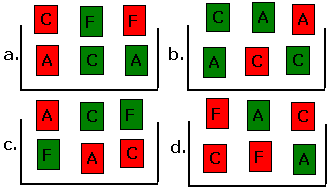Ans: Compute the weighted average of the outcomes, weighted by the probability of each outcome:
-
E(x) = x1 p1 + ... +
xn pn
Ans: The long run average of the outcomes of the random variable over a very large number of trys.
-
E(x) = x1 p1 +
x2 p2 =
0(1 - p) + 1p = p
Ans: If the events A and B are independent, then P(A and B) = P(A) P(B)
- getting at exactly 5 heads in a row?
Ans: (1/2)6 = 1/64. The sequence must be HHHHHT
- getting at least 5 heads in a row?
Ans: (1/2)5 = 1/32. The sequence must be HHHHH; we don't care what the next outcome is.
- obtaining the sequence THTTH?
Ans: (1/2)5 = 1/32
- Roll a die 4 times. What is the probability of getting at least one
ace (1)?
Ans: 1 - (1 - 1/6)4 = 0.5177 = 51.8%
- Roll a pair of dice 24 times.
What is the probability of obtaining snakeeyes (pair of aces
at least once)?
Ans: 1 - (1 - 1 / 36)24 = 0.4914 = 49.1%
If you bet on red or black, here are the payoff tables for an American roulette wheel:
|
| |||||||||||||||||||||||||||||||
What is the expected payoff of playing on red? playing on green.
Ans: Playing on red is E(x) = 1(0.474) + (-1)(0.474) + (-1)(0.052) = -0.052. You lose about 5 cents each time you play.

Ans: In a and b, letter is independent of number. To show that letter and number are independent, you need to show that for each letter value L P(L) if you don't know the color = P(L) for a given color.
For example, in Problem 8a, if you don't know the color, P(A) = P(B) = P(C) = 2/6 = 1/3. If you know the color is red, P(A) = P(B) = P(C) = 1/3. If you know the color is green, the probabilities are also 1/3.
In Problem 8c, if you don't know the color, P(F) = 2/6 = 1/3. If you know that the color is green, P(F) = 2/3 = 2/3, so color and letter are not independent.
To show that two events are not independent, it is enough to find one case where the probabilities are different; to show that two events are independent, you must show that the probabilities are the same for all choices of color and letter.
-
Person A lives at least 20 more years after February 21, 2011.
Person B lives at least 20 more years after February 21, 2011.
Ans: (1 /300,000)2 = 1 / 90,000,000,000.
Ans: 1 - (1 - p)^n = 1 - (1 - 0.03)^52 = 0.7948 = 79%.
Ans: First estimate the probability of a hole in one in a single try. The area of the hole in square feet is 14.2/144 =0.0986 ft2. If the area of the green is 4000 ft2, the probability of a hole in one is 0.1 * 0.0986 / 4000 = 2.465 × 10-6. This the probability of getting at least one hole in one in 50 years is
-
1 - (1 - 2.465 × 10-6)(50 * 52)
= 0.006389 = 0.64%
-
1 - (1 - 50 × 2.465 ×
10-6)(50 * 52) = 0.274218 = 27%